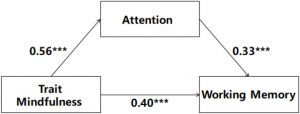
Improve Brain Processing in Mood Dysregulated Adolescents with Mindfulness
By John M. de Castro, Ph.D.
“Mindfulness-based interventions—practices that promote non-judgmental attention to the present—can help individuals respond with acceptance to challenging circumstances or emotions and is a promising approach to treatment of mood lability.” – D. M. Hafemann
Adolescence is a time of mental, physical, social, and emotional growth. But it can be a difficult time, fraught with challenges. During this time the child transitions to young adulthood; including the development of intellectual, psychological, physical, and social abilities and characteristics. There are so many changes occurring during this time that the child can feel overwhelmed and unable to cope with all that is required. This can lead to emotional and behavioral problems. Indeed, up to a quarter of adolescents suffer from depression or anxiety disorders, and an even larger proportion struggle with subclinical symptoms. Mindfulness training has been shown to improve emotion regulation and to benefit the psychological and emotional health of adolescents
The nervous system is a dynamic entity, constantly changing and adapting to the environment. It will change size, activity, and connectivity in response to experience. These changes in the brain are called neuroplasticity. Over the last decade neuroscience has been studying the effects of contemplative practices on the brain and has identified neuroplastic changes in widespread areas. In other words, mindfulness practice appears to mold and change the brain, producing psychological, physical, and spiritual benefits. The brains of adolescents are different from fully mature adult brains. They are dynamically growing and changing. It is unclear how mindfulness affects their maturing brains particularly in adolescents who have mood dysregulations.
In today’s Research News article “Network-level functional topological changes after mindfulness-based cognitive therapy in mood dysregulated adolescents at familial risk for bipolar disorder: a pilot study.” (See summary below or view the full text of the study at: https://www.ncbi.nlm.nih.gov/pmc/articles/PMC8080341/ ) Qin and colleagues recruited adolescents (13-17 years of age) who were mood dysregulated and who had at least one biological parent with bipolar disorder. They were provided a once a week for 75 minutes for 12-weeks program of Mindfulness-Based Cognitive Therapy (MBCT) adapted for children along with home practice. They were measured before and after training for emotion regulation, depressive and manic symptoms, overall global functioning, and clinical ratings. They also had their brains scanned with functional Magnetic Resonance Imaging (fMRI).
In comparison to baseline they found that after Mindfulness-Based Cognitive Therapy (MBCT) there were surprisingly no significant changes in emotion regulation, depressive and manic symptoms, overall global functioning, and clinical ratings. But there were significant increases in network efficiency and decreases in path length in the cingulo-opercular network and frontal parietal network and increases in the connectivity of brain structures within the cingulo-opercular network and the default mode network. In addition, the shorter the path length within the cingulo-opercular network the higher the level of emotion regulation.
These results need to be interpreted with caution as there was no control comparison condition and so there are potential confounding variables that could account for the results. But the psychological results are very disappointing. Mindfulness-Based Cognitive Therapy (MBCT) has been routinely found to improve emotions and emotion regulation in previous research. But it did not in the present study. It is possible that unlike with adults, MBCT is simply ineffective in improving the psychological health of mood dysregulated adolescents.
On the other hand, the functional Magnetic Resonance Imaging (fMRI) findings were interesting. The cingulo-opercular network and frontal parietal network are both involved in top-down cognitive control. The observed increases in network efficiency within these networks after Mindfulness-Based Cognitive Therapy (MBCT) suggests that MBCT improves the ability of mood dysregulated adolescents to control their thinking. This is exactly what MBCT is designed to do. Unfortunately, the researchers did not measure cognitive ability in this study, so there is no confirmatory behavioral results. The increased emotion regulation associated with decreases in path length in the cingulo-opercular network, though, suggests that the changes in the youths’ brains may be associated with improved ability to control their emotions. This may suggest an a lessened chance of developing major mental illness in the future.
So, Improve Brain Processing in Mood Dysregulated Adolescents with Mindfulness.
“With low level of mindfulness, adolescents might be lack of emotion clarity, self-control and acceptance, which in turn might lead to their poor realization of emotion and easy immersion into dysfunctional emotional reactions such as impulse and aggressive behavior toward others or blame to themselves.” – Ying Ma
CMCS – Center for Mindfulness and Contemplative Studies
This and other Contemplative Studies posts are also available on Google+ https://plus.google.com/106784388191201299496/posts and on Twitter @MindfulResearch
Study Summary
Qin, K., Lei, D., Yang, J., Li, W., Tallman, M. J., Duran, L., Blom, T. J., Bruns, K. M., Cotton, S., Sweeney, J. A., Gong, Q., & DelBello, M. P. (2021). Network-level functional topological changes after mindfulness-based cognitive therapy in mood dysregulated adolescents at familial risk for bipolar disorder: a pilot study. BMC psychiatry, 21(1), 213. https://doi.org/10.1186/s12888-021-03211-4
Abstract
Background
Given that psychopharmacological approaches routinely used to treat mood-related problems may result in adverse outcomes in mood dysregulated adolescents at familial risk for bipolar disorder (BD), Mindfulness-Based Cognitive Therapy for Children (MBCT-C) provides an alternative effective and safe option. However, little is known about the brain mechanisms of beneficial outcomes from this intervention. Herein, we aimed to investigate the network-level neurofunctional effects of MBCT-C in mood dysregulated adolescents.
Methods
Ten mood dysregulated adolescents at familial risk for BD underwent a 12-week MBCT-C intervention. Resting-state functional magnetic resonance imaging (fMRI) was performed prior to and following MBCT-C. Topological metrics of three intrinsic functional networks (default mode network (DMN), fronto-parietal network (FPN) and cingulo-opercular network (CON)) were investigated respectively using graph theory analysis.
Results
Following MBCT-C, mood dysregulated adolescents showed increased global efficiency and decreased characteristic path length within both CON and FPN. Enhanced functional connectivity strength of frontal and limbic areas were identified within the DMN and CON. Moreover, change in characteristic path length within the CON was suggested to be significantly related to change in the Emotion Regulation Checklist score.
Conclusions
12-week MBCT-C treatment in mood dysregulated adolescents at familial risk for BD yield network-level neurofunctional effects within the FPN and CON, suggesting enhanced functional integration of the dual-network. Decreased characteristic path length of the CON may be associated with the improvement of emotion regulation following mindfulness training. However, current findings derived from small sample size should be interpreted with caution. Future randomized controlled trials including larger samples are critical to validate our findings.
https://www.ncbi.nlm.nih.gov/pmc/articles/PMC8080341/
 By John M. de Castro, Ph.D.
By John M. de Castro, Ph.D.







